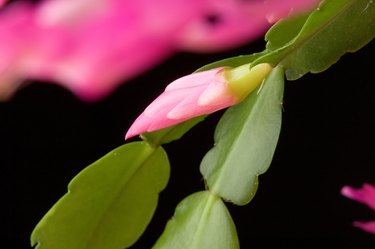
Christmas cactus (Schlumbergera spp.) explodes into brilliant bloom between late autumn and spring, while most other plants enjoy a well-earned siesta. Also known as zygo, holiday, Thanksgiving or crab cactus, it thrives in pots outdoors in U.S. Department of Agriculture plant hardiness zones 10 through 12, and as a flashy houseplant elsewhere. The wild plants root in organic debris that accumulates in the branch crotches of Brazilian rainforest trees. Cultivated Christmas cacti perform best in acidic, porous growing medium.
Perfect pH for Christmas Cactus
Video of the Day
A growing medium's pH measures its degree of acidity or alkalinity. Those with a pH of 7.0 are neutral, and any lower reading is acidic. Christmas cacti planted in media registering between 5.5 and 6.2 have the most vigorous growth and abundant blooms. Commercially available potting soil for Christmas cactus has the required acidity. To create your own Christmas-cactus growing medium, amend 4 parts African violet potting mix with 2 parts pumice or perlite. African violet mix contains acidity-boosting peat moss, while the pumice or perlite increases its porosity for good drainage.
Video of the Day
Necessary Nutrition for the Zygo Plant
Like most plants, Christmas cactus plants photosynthesize food by using the sun's energy to transform carbon dioxide and water into carbohydrates. The chlorophyll that gives your cactus its green coloration plays an essential role in photosynthesis. In Christmas cacti, the micronutrient magnesium matters more to chlorophyll production than it does in most plants.
To keep your indoor or outdoor potted plant at its peak, dose it once monthly between the time it stops flowering and the end of August with a solution of 1 teaspoon of Epsom salts in 1 gallon of water. Supplement this treatment with a monthly dose -- during the same months -- of 20-20-20, water-soluble fertilizer applied at one-half the label's recommended strength. Space the different treatments at least a week apart, and stop them after the buds appear.
Watch the Water
During spring and summer, your Christmas cactus is content to have the top 1/2 inch of its medium dry to the touch between drinks. A budding or flowering plant, however, needs consistently moist medium; without it, the buds drop. Regardless of the season, no Christmas cactus tolerates saturated soil or standing water in its runoff saucer. A suitably porous medium prevents waterlogging. If yours doesn't drain rapidly, add perlite or pumice.
The Reblooming Regimen
Even ideal growing medium, watering and feeding won't result in a reblooming Christmas cactus if you don't also provide proper temperatures and lighting. Shade an outdoor plant during spring and summer and give it full sun in fall and winter. Indoor Christmas cacti like a brightly lit area out of direct sun.
Beginning in mid-September, set an outdoor or indoor plant in a closet or other location with complete, uninterrupted darkness for 14 hours each night for at least six weeks. During the day, place it in its normal spot and maintain a temperature close to 68 degrees Fahrenheit. If that's not possible, maintaining fall temperatures between 60 and 68 degrees F during the day and 50 to 59 degrees F at night stimulates bud formation, but the buds may drop at the cooler end of that range.
- Missouri Botanical Garden: Schlumbergera Truncata
- University of Florida Mid-Florida Research & Education Center: Holiday Cactus Production Guide
- Clemson Cooperative Extension: Thanksgiving and Christmas Cactus
- North Carolina Department of Agriculture & Consumer Services: Kids' World -- Plant Nutrients
- North Dakota State University Extension Service: Questions On: Christmas Cactus